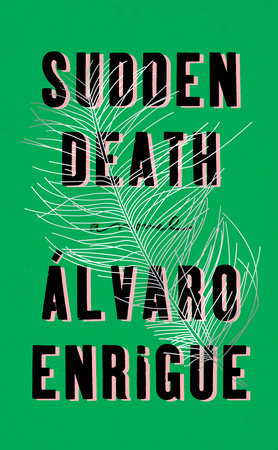Sudden Death
by Álvaro Enrigue, translated by Natasha Wimmer
reviewed by Gabriel García Ochoa
It’s a little disheartening to think I may have already read the best book I’m going to read this year–or at least one of the best. The premise of Sudden Death, Álvaro Enrigue’s fifth novel and the second to be translated into English, invites one of two possible effects: smiles, or furrowed brows. Francisco de Quevedo, Spanish poet of the Baroque, plays a tennis match against another Baroque titan, the Italian painter Michelangelo Caravaggio, with a ball made from the red, “incendiary” braids of beheaded Anne Boleyn. How’s that for an introduction?
The proposition of Enrigue’s novel is fascinating: what would have happened if these two monsters, similar in so many ways, had met? Sparks, no doubt, of hatred and attraction. Both Quevedo and Caravaggio were visceral characters who had to flee justice for killing hapless bystanders in the heat of an argument: Caravaggio after a tennis match, Quevedo after mass. Both were acquainted with some of the most important figures in Europe (their linesmen in the novel are the Duke of Osuna and Galileo Galilei). And of course, Caravaggio and Quevedo were masters of the paintbrush and the pen, giants whose influence cast deep and lengthy shadows across the Baroque period and beyond.
In the novel, Enrigue quotes an entry from Sebastián de Covarrubias’s famous Treasury of the Castilian or Spanish Language, the first monolingual Spanish dictionary. The entry is for the word “ball” in Spanish, pelota, which is etymologically linked to the word pelo, hair–not surprisingly, because tennis balls used to be stuffed with human hair (apparently, it made them bounce better). The braided narrative of Sudden Death, with the intersecting backstories of Quevedo and Caravaggio, Boleyn’s execution and the Counter-Reformation, rising and ebbing papacies, and the quiet, powerful influence of the Conquest of the New World, reminds me of those tennis balls: Enrigue’s mercurial book ricochets in the most unexpected directions. How did a miter crafted next to the shores of Lake Pátzcuaro in Mexico by master featherworker Diego de Alvarado Huanitzin, a surviving noble from the royal court of Moctezuma, make its way to Rome to change the course of Western art history? In what strange, circuitous way is Quevedo’s tennis serve linked to the infamous conquistador, Hernán Cortés? And how, in the name of heaven, did Caravaggio and Quevedo come to face each other on a tennis court?
If you’re going to tackle giants, you had better be strong, or clever, and Enrigue is both. Every sentence in Sudden Death shows his command of the story. There are sections where he does something that I have only seen executed this well in a novel by Nobel Prize-winner Mario Vargas Llosa, La ciudad y los perros (bizarrely translated into English as The Time of the Hero): interweaving all the separate story lines in one continuous, flowing paragraph.
Caravaggio tilted the miter, saw that the figures came to life. Their faces changed; Christ rose up in an exercise of celestial swimming that was his salvation and no one else’s, the salvation of those who die in combat, no matter what kind—this novel is the combat. He half closed his eyes, which was the only way he could bring into focus the background of the red leaves and branches that twined around the rest of the images. Whoever made this, he thought, can read God’s design. When silence fell, the poet said: I’m still in. He had understood that this wasn’t a game of tennis, but a sacrifice. The Indian smiled, showing what looked to the priest like the teeth of a warrior. The red is the blood of the earth, the veins of the world, said the bishop; God’s design. The mushrooms help, said Don Diego. He continued: Take one with you for Don Zumárraga, so that he’ll send you to see His Holidays; it’s you who can best speak for us. The poet rose and picked up the ball and racket, the little figures retreating respectfully from the court that was swimming in a sea of red.
Sudden Death is also an enjoyable pastiche of sources and styles. The shortest chapter is three sentences long. Other chapters include archival letters, dictionary entries, book excerpts, a meeting between two cardinals and a pope written as a screenplay, and emails between a fictional Enrigue and his editor, discussing the progress of the novel (a conversational to-and-fro which mirrors Quevedo and Caravaggio’s match). Enrigue even manages to insert commentaries on contemporary Mexican society, which he describes, touchingly, as “a third nation, blind to its own beauty, that no one has been able to understand.”
Natasha Wimmer is a consummate translator. Her previous works include Chilean writer Roberto Bolaño’s The Savage Detectives, and his behemoth of a novel, 2666, both now of canonical status in Latin American literature. She is also the translator of three works by Vargas Llosa, The Way to Paradise, Letters to a Young Novelist, and The Language of Passion. Wimmer’s translation of Sudden Death is exquisite, honest, and creative. There are sections in the novel that hinge on phonetic wordplay; in one chapter, an Aztec survivor of the fall of Tenochtitlán who has recently learned Spanish is continually mispronouncing words, leading to beautiful misunderstandings. He talks about cockles instead of buckles when describing Hernán Cortés’ shoes, and when a cook tells him they are having calf’s liver for dinner, he wonders why the Spanish nobility would want to eat “castle adder,” which he surmises to be a tasty “fat snake that lives in ruined towers.” Wimmer negotiates these linguistic complexities elegantly: the wordplay is still present and it works in English, indicating a very subtle, well-managed domestication of the Spanish original.
Published on October 12, 2016

